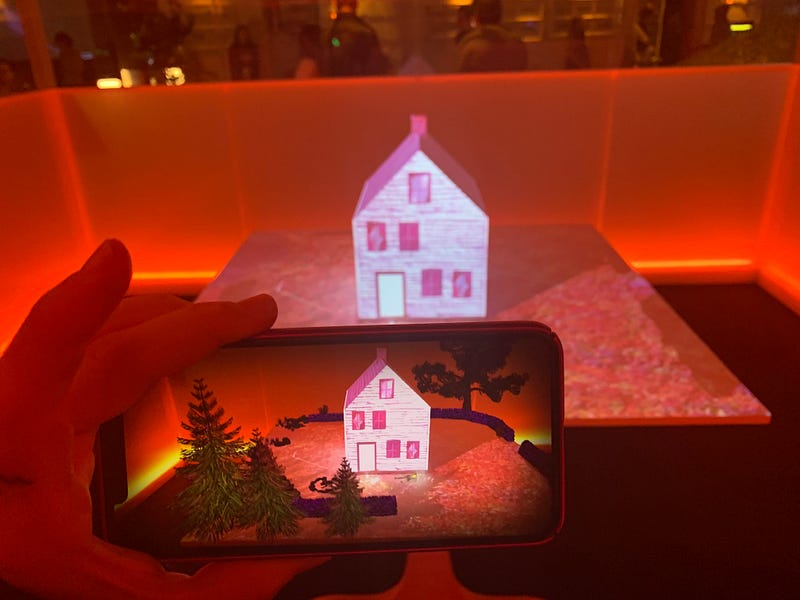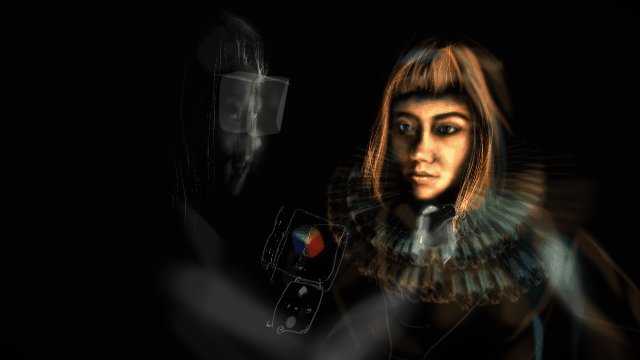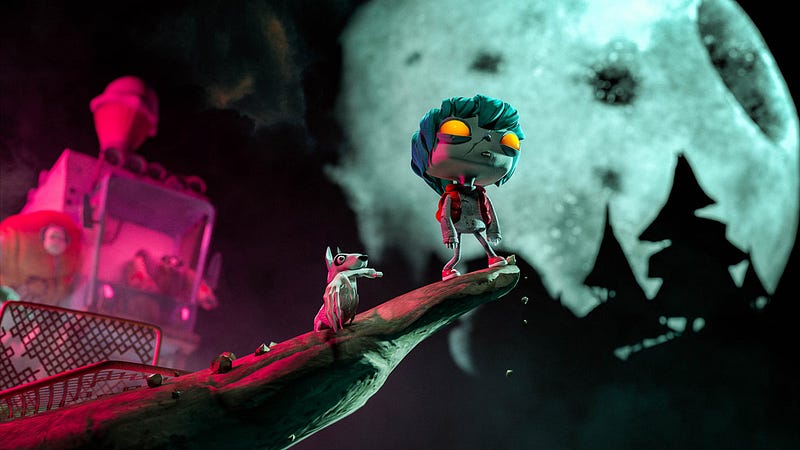
At Sundance, Excitement, Anxiety, and an Ecosystem in the Making
The anticipation of Sundance is fraught with both excitement and anxiety. What gem will I find? How are artists experimenting with emerging technology this year and how are they pushing the field forward? What’s the zeitgeist? What new technique will define the field and what will disappoint me so much that I wish I were here to watch linear films instead?
With that anticipation comes the anxiety about crowds and inaccessibility. How am I going to see the work? As the tickets disappear and I am told to come back the next day, I am faced with the existential crisis of working in a field inaccessible to most people even though accessibility is dear to my heart. If I can’t see most work and I work in the industry, how will the general public? As I run into colleagues, we shake our heads and complain. How are we, as a field, going to solve this issue? (Many good people are working on it.)
This year, however, I was able to see most of the installations. This doesn’t solve the larger problem of accessibility, but it solved my own very small problem of navigating Sundance. I arrived at the end of the first weekend rush and stumbled upon a secret: the work is available to experience during New Frontier Central “after hours.” Who knew? Not many apparently, because there were few people.
Here are a few of my observations.
Over the last few years, VR has monopolized Sundance New Frontier but this year AR finally had a more robust, mature presence — the long-anticipated Magic Leap AR appeared on the scene. Magic Leap’s strategy for distribution and integration is to partner with artists and cultural institutions and I have to say, I enjoyed the experiences. I could see myself choosing to watch the Seven Ages of Man created by the Royal Shakespeare Theater in my living room. Of course, that won’t happen any time soon because the headsets cost almost $3000. But one can imagine a world where indeed all the world is a stage.
 The Dial
combines an installation with mobile AR so users can navigate a murder mystery at their own pace.
Photo by Jessica Clark
The Dial
combines an installation with mobile AR so users can navigate a murder mystery at their own pace.
Photo by Jessica ClarkAnother AR experience, The Dial, creatively played with audience agency by letting the leader of an audience team of three determine the sequence of scenes based on which direction they moved. I also appreciated the low tech shadow dance piece Antiquated AR, reminding us that while the technologies may be new, practices, including augmented reality, are old.
Embodied experiences are one of the exciting aspects of emerging, interactive media. Your movements affect the narrative structure and, in some cases, you become part of the story experience. For more on this theme, see OpenDocLab Research Assistant Sam Mendez’s excellent article, “Sundance VR: The 2019 Festival Showed That the Future Is Not Passive Viewing.”
 At Sundance,
a total of 223 people were hand-painted into the Grisaille experience. Learn more.
At Sundance,
a total of 223 people were hand-painted into the Grisaille experience. Learn more.I found Grisaille to be a particularly poetic rendition of an embodied, participatory experience—or, as curator Shari Frilot describes it, “biodigital looping-digital platforms that begin and end by connecting with a human being who connects to that same platform.”
In the first half of Grisaille, you put on a headset and are virtually immersed in a beautiful 3-D painting that artist Teek Mach created with Google’s Tilt Brush. In the second half, you enter another physical room, where the artist is present. She paints the outline of your body and adds it to the painting that you just saw in the headset now projected on a wall. You watch your body float off into her painted universe together with the outlined bodies of all the viewers who came before you. It felt spiritual as you saw yourself float away and become part of the universe, as if you were watching your human spirit leave your physical body. When I exited the room, I said to the attendant, “I feel like I just died. “
One of the most powerful pieces was the VR documentary Traveling While Black, a 360 VR experience based on the play and the midcentury travel guide by the same name, Green Book. Updated annually, it listed safe places for black Americans to buy food and gas and to find safe accommodations during the racial violence of the Jim Crow era. Set in one of the diners listed in the guide, Ben’s Chili Bowl, it takes you through the decades and makes the point that the discrimination and danger hasn’t gone away, especially for black men. One of the most poignant moments is an interview with Samira Rice, the mother of Tamir Rice, the Cleveland teenager shot by the police recounting the story of her son’s shooting and the police’s treatment of her.
 Gloomy Eyes image courtesy of the Sundance
Institute.
Gloomy Eyes image courtesy of the Sundance
Institute.Gloomy Eyes was one of my favorites. It’s a delightful and eerie animated fable about an outlawed zombie named Gloomy, his friendship with a human girl, and the transcendent power of love. The transitions between scenes were brilliant. Gloomy and his friend leap and slide down mountains from one scene to the next, seamlessly guiding you through the story and transitioning you from scene to scene with his moves.
A panel about volumetric filmmaking revealed an ecosystem in the making. Panelist Nonny De La Peña was at Sundance this year with her new tool, Reach, a web platform for creating and sharing volumetric VR. Panelists Yasmin Elayat and Alexander Porter from Scatter discussed their tool for volumetric capture, Depthkit, now a staple in the volumetric filmmaking field. Vimeo has also moved into the immersive media space, forming Vimeo Creators Lab to explore “immersive environments, social participation, machine learning, to help re-imagine the future of storytelling.” You can now live stream holograms, for instance, or an AI film. Nonny’s comment summed up the panel best: “If the world is not flat, why should our media be?”
A few projects this year tackled our troubling AI conundrum. Mechanical Souls explored AI themes such as who’s responsible when AI errs. The project, Mica, that has you don an AR headset (Magic Leap One) and puts you face-to-face with an AI hologram, left me wondering how to relate to this awkward smiling hologram who stared back at me from across the desk. I learned later that this exchange was a homage to Marina Abramovic’s “The Artist is Present.” But Mica also insisted that I hang a picture on the wall and the experience would not end until I hung the picture up. A lot of art projects these days prompt us to do what the AI asks. And most of us do. Are they training us to give ourselves over to AI or showing us that we already have?
Since the best art is a mirror onto ourselves, one we don’t always want to look into, Sundance was no exception. One can and certainly should celebrate the wonderful creativity and experimentation, the new languages emerging, the quest to understand and reflect what it means to be human told from diverse perspectives. In fact, the website states that 48% of the projects were directed or led by one or more women, 39% were directed or led by one or more artist of color, and 9% by one or more people who identify as LGBTQIA. That’s better.
But with our current landscape of emerging tech — VR, AR, and AI — and prototypes as art, I couldn’t help but think about how even here, amongst these beautiful, snow-covered mountains, expansive skies, and crisp, fresh air, we are surveilled, our moves observed and recorded. We are data. Data without consent. Or maybe, for many of us, with consent. It’s our Faustian bargain.
Immerse is an initiative of the MIT Open DocLab and The Fledgling Fund, and it receives funding from Just Films | Ford Foundation and the MacArthur Foundation. IFP is our fiscal sponsor. Learn more here. We are committed to exploring and showcasing media projects that push the boundaries of media and tackle issues of social justice — and rely on friends like you to sustain ourselves and grow. Join us by making a gift today.